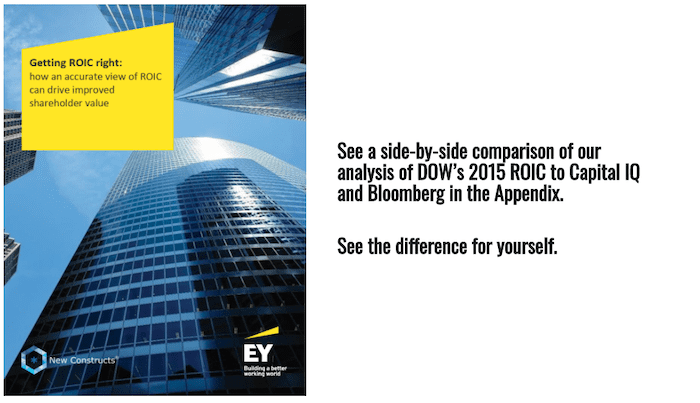Ernst & Young white paper shows our financial models are superior.

Key quotes:
Why Ernst & Young chose New Constructs:
- “To test our hypothesis of the importance in getting the data right to drive meaningful improvement dialogue with our clients, EY worked with an independent analytics firm, New Constructs.” Page 3
- "New Constructs uses machine learning technology to read through annual and quarterly reports and make numerous adjustments to close accounting loopholes and provide apples-to-apples comparability across thousands of companies.” Page 3
Comparing our research to Capital IQ and Bloomberg:
- “We conducted an ROIC analysis of four firms and analyzed the side-by-side results of New Constructs data in comparison to two of the largest financial data houses.” Page 4
[Note: the four firms are Dow, Comcast, UPS, & Caterpillar.]
Our data makes a BIG difference:
- “Our analysis demonstrates that the ROIC calculations for the selected companies varies significantly across the three data sources over a six year period.” Page 4
What creates the difference:
- “The majority of the difference, though, comes from New Constructs’ machine learning approach, which leverages technology to calculate ROIC by applying accounting adjustments that may be buried deeply in the footnotes across thousands of companies.” Page 4
How they know the difference is real:
- “The other advantage of New Constructs is the transparency in disclosing calculations and all the data behind them. It is hard to determine the calculations at a granular level from the reports of many data providers.” Page 4
See the difference:
- “Below are examples of ROIC calculation adjustments that New Constructs made for Peer 2, Peer 3 and Peer 4.” Page 4
- The entire Appendix for a side-by-side comparison of our analysis of DOW’s 2015 results to Capital IQ and Bloomberg.

4 replies to "Getting ROIC Right – Get The White Paper"
Great post.
Quick question: What about long-term deferred revenue? It’s not a current liability but it’s not money from the creditors or shareholders either. Shouldn’t it be removed from the invested capital?
We treat long-term deferred revenue similarly to deferred tax liabilities, as a form of low-cost debt. Even though the company doesn’t have to pay interest on this deferred revenue, it’s still being used to fund operations.
Have some questions about your and Stern Stewart’s theory of value (i.e. NOPAT, I.C., ROIC, WACC, EVA)
Don’t want to write one here that’s not going to go anywhere.
Do you have a link that readers can use to bounce a question, etc. off you once in a while?
Carl,
Feel free to contact us with your question through Customer Support at support@newconstructs.com.